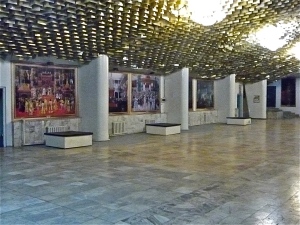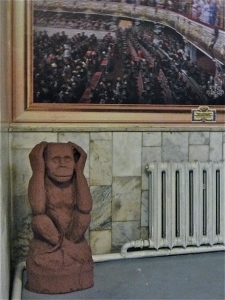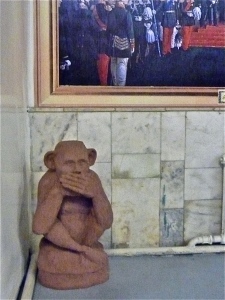September means different things to different people. To people around the world interested in fashion, it means the month of international fashion weeks:
Sept. 6 – Sept. 13: NEW YORK
Sept. 14 – Sept. 18: LONDON
Sept. 19 – Sept. 25: MILAN
Sept. 25 – Oct. 3: PARIS
September 28: BISHKEK
No, not a typo, the last one. Don’t count out Bishkek, fashionistas! Place Kyrgyzstan on your maps! I have recently stumbled into the world of Kyrgyz fashion design, and there is lots going on, and lots to write about. Granted, Bishkek is out of step with the slightly more famous fashion capitals when it comes to scheduling: This year’s Bishkek Fashion Week took place in April (April 3-8). Missed it. But September 28 was the day of the Tumar Fashion Show.
Tumar Art Salon is a store in Bishkek that sells crafts made, primarily, by Kyrgyz women who use traditional fabrics (mostly felt) and patterns to produce clothes, slippers, scarves, hats, bags, and other accessories. They also make lovely toys steeped in Kyrgyz culture and history and gorgeous interior design objects such as rugs, pillow cases, and pottery. Tumar is much more than a store; I would describe it as a creative project that seeks to preserve Kyrgyz cultural heritage by adding a modern twist to it and by creating a sustainable manufacturing system. What I see in Tumar mirrors what I observe in a lot of other sites of Bishkek’s cultural landscape and in the Kyrgyz state education system: a post-Soviet revival of a national culture, including the revival of the Kyrgyz language, and of a distinct ethnic identity. And this precarious ethnic/national interrelationship in post-Soviet Kyrgyzstan makes for the most interesting conversations here, especially with young people. It is not surprising, but nevertheless significant, that the terms “historical memory,” “ethnic self-identification,” and “national culture” reverberate in Tumar’s online description of its history and purpose:
And now to the Tumar Fashion Show.
The Setting: Imperial Fantasies Housed in Raw Concrete
The setting: the Russian Drama Theater. A prime example of Soviet architecture of the 1970s, which defines the face, and feel, of the city.
But once you step inside this Soviet colossus of concrete, you enter the world of imperial Russian fantasies. The lobby: a gallery devoted to the Romanovs. The appearance of monumental paintings in gold frames: itself a fantasy. The paintings, frames, and plaques alike are printed on wallpaper.
In the Russian Drama Theater, the Romanovs rule. And they show it: from displays of magnificent splendor at the Bolshoi Theater and other official events to individual portraits:
The first to greet you: Nicholas Alexandrovich Romanov, known as Nicholas II, La Majesté Impériale L’Empereur, the last tsar of Russia. On horseback, stirring up some dust with his Chevalier Garde and stirring up memories of imperial Russia:
In addition to the walls depicting the entire family line, one wall, in imperial fashion, is dedicated to military battles: the battles of Russia’s “Patriotic War” of 1812 against Napoleon’s invading army. The 19th century world in upheaval is neatly ordered at the Russian Drama Theater. On display here: dramatic visuals and a study in historical memory and in taxonomy of pictures of the past.
To make the tripartite structure of imperial representation complete, the patriarchs get their fair share of wall space, too:
But not all are eager to witness the spectacles of coronations, declarations, and other rituals of power. Ironically, in what seems a random choice of placing random objects in a public building, the three wise monkeys don’t want any of it:
Prelude to a Bishkek Fashion Show
Like any other fashion event, the Tumar Fashion Show must start with a report from the red carpet. So in the lobby of the Russian Drama Theater, where the crowd was gathering along the Romanovs, I scanned the red(dish) carpet. For shoes. The pre-show stopper and my pick of the night: this stunning pair:
A glimpse of red soles! What would Christian Louboutin say? Well, in Bishkek, people do not exactly mind the original, and not only when it comes to shoes. Life here offers a whole new interpretation of The Real Thing. What is real, though, is that this is the skyrocketing standard heel in Bishkek:
More proof for just how much the women here love their heels? They love them THIS much:
No city for old loafers.
Also, no Veuve Clicquot or Moët&Chandon that Friday night in the lobby of the Russian Drama Theater. Not even Russian or Kyrgyz champagne, the usual fare in Bishkek. But in the building’s basement café, some delicious cakes and pastries on display. Now we are talking how to start a fashion show:
Paris, London, Milan, New York…Bishkek!
Versace, Chanel, Alexander McQueen? Sure. Meerim Mamytkanova, Sonun Nurmanbetova, Aidai Sharshekeeva? Kyrgyzstan. Marc by Marc Jacobs? ObbO by Sumsarbek Mamyraliev. Granted, there might be perks about being at the international events in New York, Milan, and Paris. But not so fast underrating the Bishkek fashion event experience.
Chatting photography with David Sims at the Vogue and Vanity Fair dinner in Paris? Splendid. Chatting about the remarkable Kyrgyz photographer George Kolotov (http://georgekolotov.com) over Lakhman (a traditional Kyrgyz dish) in a restaurant on Chui Street? Bishkek. Mingling with Anna Wintour at the Dolce&Gabbana show in Milan? Sure, very much en vogue. But how about a cigarette and tea in the company of Tsesarevich Nicholas Alexandrovich Romanov and the Grand Dukes Paul Alexandrovich and Sergei Alexandrovich, who are keeping their cool in the lobby of Bishkek’s Russian Drama Theater?
Catwalk!
Oh, yes, the actual fashion. Let’s not forget.
Here is my “best of” selection. Live from Bishkek’s catwalk: fashion design from Kyrgyzstan.
An eclectic mix gliding by on the catwalk: from glamorous, embroidered dresses to delicate, hand-knitted sweaters to elegant winter coats made out of felt. It was, above all, the night of amazing felt hats. Making me, for one brief moment, look forward to winter, despite all the gloomy anecdotes of just how cold the last one was and the predictions of how cold the next one will be. And despite the stern advice of how badly I will need a fur hat in order to make it through the dreaded and long Bishkek winter months (an adamant NO!). For now, basking in the sun of the Central Asian version of a glorious Indian Summer (though it did snow big flakes on one strange afternoon in October), in stubborn resistance and sweet denial, and indulging in the fantasy of elegantly sliding on icy sidewalks in Tumar style, I bought (aside from a great skirt and blouse by Sonun) the white hat that looks, as one person commented, like a medieval helmet (Seriously: better than a fur hat. Much better.). Because the day after the show, all outfits -all originals- were for sale at Tumar. Truly prêt-à-porter.
That day, and the following days, the little store at the corner of Isanova and Kievskaia streets became the site of the post-show: our own version of a fashion show, without Friday night’s spotlights and cameras. Our turn. To parade and turn around in front of the mirror, to stride back and forth. Here, a random cast of women communicating in bits of Russian, English, and German had a blast trying on these beautiful clothes. And admiring each other in them, offering unsolicited and solicited advice, commenting in that particular, and enabling, way in which women, complete strangers, interact when they try on clothes in stores (“Wow!”/“Too small on you? NO! Perfect on you!”/”Amazing! You MUST get it!”). Or, as one woman simply sighed in an exclamation of admiration, instead of using a series of words: “Ach.” And I learned a whole new meaning of “Ach.” A matter of intonation. Not the German, heavy-hearted and lamenting “Ach,” but a soulful “Ach” full of awe. No translation necessary, as so often in Bishkek. That “Ach” then traveled back and forth between women changing outfits and became, for a brief moment, the new universal language, and the running joke, between us. Now THAT fashion experience you cannot get at the fashion weeks in New York, London, Milan, and Paris. Ach, Bishkek.


















